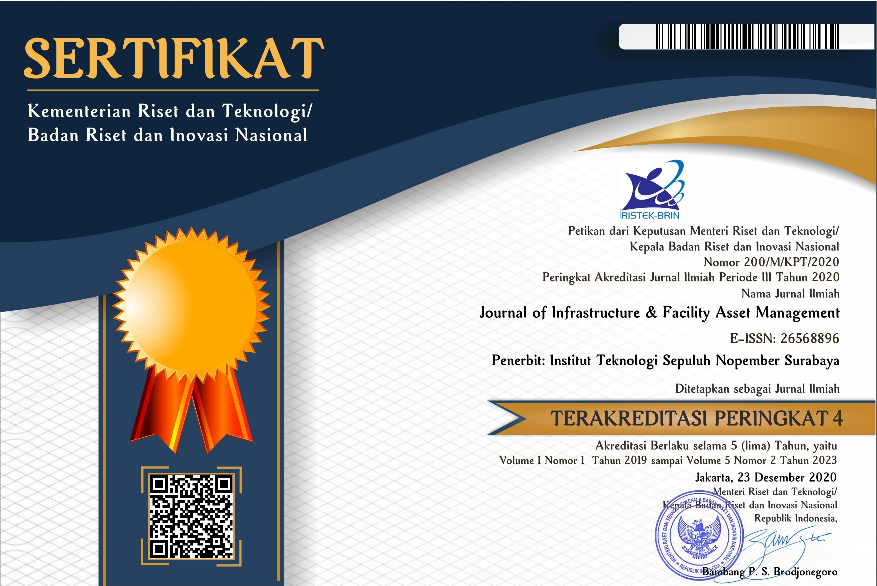Preliminary Recognition of River Infrastructure
Abstract
River infrastructures can be defined as facilities and structures that support all activities related to river. Many infrastructures that exist along river stream but few of them are listed and recognized as an important part in the river system. The condition of assets that support the river function should be considered since it determines the sustainability of water supply system for many areas. Starting from upstream, there were dam and reservoir that constructed to reserve the water. Moreover, the water can be distributed to the downstream area for many requirements, such as irrigation system, hydro power, industrial process, etc. In the other hand, dam and reservoir also functioned as flood control that protect the downstream area from flood and inundation. In alluvial river, there were erosions that occurs as river flow velocity could transported soft soil numerously. Hence, the river bank protections were built in order to protect the nearby river infrastructures. Therefore, the infrastructures recognition as preliminary assessment to the river asset management need to be done in order to maintain the river system.
Full Text:
PDFReferences
Insukindro & Aliman (1999). “Pemilihan dan Fungsi Empirik: Studi Kasus Perminatan Uang Kartal Riil di Indonesia. Jurnal Ekonomi dan Bisnis Indonesia. Vol. 14, No. 4:49-61.
Azmat Hussain & Sumaira Jan. (2016). “Bridge failure causes in extreme flood events”. International Journal of Civil Engineering and Technology (IJCIET). Vol. 7, Issue 5, pp. 216–221, Article ID: IJCIET_07_05_023
Chengjia Su, Xiaohong Chen (2019). “Assessing the effects of reservoirs on extreme flows using nonstationary flood frequency models with the modified reservoir index as a covariate”. Advances in Water Resources, Vol. 124, February 2019, Pages 29-40
Chunyuan Liu and Ulysse Seho F. Hounsa (2018). “Analysis of Road Embankment Slope Stability”. Open Journal of Civil Engineering. Vol. 8 No. 2. doi: 10.4236/ojce.2018.82010
Daniel Vázquez-Tarrío, Michal Tal, Benoît Camenen, Hervé Piégay (2019). “Effects of continuous embankments and successive run-of-the-river dams on bedload transport capacities along the Rhône River, France”. Science of The Total Environment, Vol. 658, 25 March 2019, Pages 1375-1389.
Elizabeth Mettetal (2019). “Irrigation dams, water and infant mortality: Evidence from South Africa”. Journal of Development Economics, Vol. 138,,pp. 17-40.
Gerald E. Galloway Jr (1995). “New directions in floodplain management”. Water Resources Bulletin. 1995, https://doi.org/10.1111/j.1752-1688.1995.tb04024.x.
Gideon Johannes Bonthuys, Marco van Dijk, Giovanna Cavazzinic (2019). “Leveraging water infrastructure asset management for energy recovery and leakage reduction”. Sustainable Cities and Society. Vol. 46, 101434.
Ian C. Campbell (2016). “Integrated management of large rivers and their basins”. Ecohydrology and Hydrobiology. Vol. 16, Issue 4, pp. 203 – 214.
Jacob V. E. Katz, Carson Jeffres, J. Louise Conrad, Ted R. Sommer, Joshua Martinez, Steve Brumbaugh, Nicholas Corline, Peter B. Moyle (2017). “Floodplain farm fields provide novel rearing habitat for Chinook salmon”. Journal Pone.
Jin Luo, Qi Zhang, Liang Li, Wei Xianga (2019). “Monitoring and characterizing the deformation of an earth dam in Guangxi Province, China”. Engineering Geology, Vol. 248, pp. 50-60. https://doi.org/10.1371/journal.pone.0177409.
Michael Church (2006). “Bed Material Transport and the Morphology of Alluvial River Channels”. Annu. Rev. Earth Planet. Sci. 34:325–54. doi: 10.1146/ annurev.earth.33.092203.122721.
O.K. Saleh, E.A. Elnikhely, Fathy Ismail (2019). “Minimizing the hydraulic side effects of weirs construction by using labyrinth weirs”. Flow Measurement and Instrumentation, Vol. 66, pp. 1-11.
P.Angriani, Sumarmi, I.N.Ruja, S.Bachri (2018). “River management: The importance of the roles of the public sector and community in river preservation in Banjarmasin (A case study of the Kuin River, Banjarmasin, South Kalimantan – Indonesia)”. Sustainable Cities and Society, Vol. 43, pp. 11-20.
Paulina Budryte, Sonja Heldt and Martin Denecke (2018). “Foundations of the participatory approach in the Mekong River basin management”. Science of The Total Environment. Vol. 622–623, pp. 349-361.
Roma Bhatkoti, Glenn E. Moglen, F. ASCE, Pamela M. Murray-Tuite, A.M. ASCE, and Konstantinos P. Triantis (2016). “Changes to Bridge Flood Risk under Climate Change”. Journal of Hydrologic Engineering. Vol. 21, issue 12.
Soemitro, R.A.A. & Suprayitno, H. (2018). “Pemikiran Awal tentang Konsep Dasar Manajemen Aset Fasilitas”. Jurnal Manajemen Aset Infrastruktur & Fasilitas, Vol. 2, Sup. 1, Juni 2018, Hal. : 1-13.
Suprayitno, H. & Soemitro, R.A.A. (2018). “Preliminary Reflexion on Basic Principle of Infrastructure Asset Management”. Jurnal Manajemen Aset Infrastruktur & Fasilitas, Vol. 2, No.2, Maret 2018, Hal. : 1-9.
Xenaki, V., Doulis, G., and Athanasopoulos, G (2016). “Geotechnical Design of Embankment: Slope Stability Analyses and Settlement Calculations”. International Journal of Geoengineering Case histories. 2016. Vol.3, Issue 4, p.246-261. doi: 10.4417/IJGCH-03-04-04.
Yuniarti Yuskar, Dewandra Bagus Eka Putra, Muhammad Revanda (2018). “Quarternary Sediment Characteristics of Floodplain area: Study Case at Kampar River, Rumbio Area and Surroundings, Riau Province”. JGEET. 2018. Vol. 3 No. 1. doi: https://doi.org/10.24273/jgeet.2018.3.1.1226
DOI: http://dx.doi.org/10.12962%2Fjifam.v1i1.5202
Refbacks
- There are currently no refbacks.
Visitor :
Flag Counter

Journal Of Infrastructure & Facility Asset Management by Institut Teknologi Sepuluh Nopember is licensed under a Creative Commons Attribution-ShareAlike 4.0 International License.
http://earthlearning.unimol.it/
Kementerian Pemberdayaan Perempuan dan Perlindungan Anak Indonesia
BRIN - Badan Riset dan Inovasi Nasional
https://www.cityofnorthfield.org/
Website Resmi Bogor TimurIndonesia
TabolakkabResmi Kabupaten Konawe Selatan
Rumah Pangan KitaDistribusi Pangan Resmi Peluang Usaha Modal Terjangkau
Direktorat Jenderal PajakTerkini Dan Terpercaya
Kabupaten MadiunIndonesia
Rumah Sakit Umum Kabupaten KendalMasyarakat Selalu Hidup Sehat Dan Bahagia
Kadin SumateraSistem Informasi Kamar Dagang Industri Indonesia
Kadin Sumatera SelatanSistem Informasi Kamar Dagang Industri Indonesia
k
Kota DemakTerkini Dan Terbaru Hari Ini
Berita Kota MadiunTerkini dan Terbaru Hari ini
RS UIUniversitas Indonesia
Rumah Sakit Umum RSUD CicalengkaProvinsi Jawa Barat
Children's NationalHospital - Ranked Top 10 in the Nation
Murni Teguh Memorial HospitalKota Jakarta
Mayo ClinicRochester,Minnesota
RS PersahabatanKota Jakarta Timur
RS Adam Malik MedanTerjangkau, Efisien, Nyaman
(RSUD) Dr. Dradjat PrawiranegaraKabupaten Serang
https://kemkespapuaselatan.id/
https://kemkespapuapegunungan.id/
https://kemkesbengkuluprov.id/
BMKG - Badan Meteorologi, Klimatologi, dan Geofisika Indonesia





